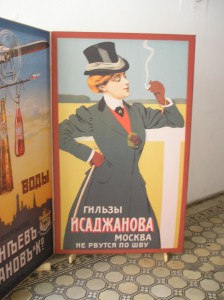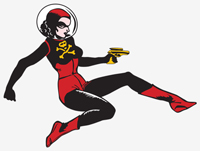Having had it with organized tours, we decided to spend the next day on a self-guided walking tour of Krakow. (Translation: we had a map and a guidebook and we started walking.)
This is a fabulous way to see a fabulous city. You can read about Krakow in many a guidebook and web page, so we won’t provide a full travelogue. Rather, we will give you our own personal highlights:
- In Rynek Główny (the city’s largest market square), we eat breakfast while listening to a trio of accordion players belt out the William Tell Overture as horse drawn carriages clopped past.
- The extravagant decoration of the basilica of the Virgin Mary (or Kosciol Mariacki) warms my heart. Every square inch of the interior is decorated with gold or stars or paintings or carvings. What could be better? Anything worth doing is worth overdoing, I say.
- We visit Galicia Jewish Museum, which was created to commemorate the victims of the Holocaust and to celebrate Polish Jewish culture. The permanent exhibition, Traces of Memory, offers a view of the Jewish past that was destroyed in Poland, documents the Holocaust, and offers a look at current efforts to preserve and recreate the memory of the Jewish past in Poland today. The museum focuses on Galicia, an area now split between the Ukraine and Poland and coincidentally, the area from which my grandfather emigrated to Canada.
- We descend 135 narrow stone steps in a dark passageway below Wawel Castle to the Dragon’s Cave. Legend has it that a dragon menaced the city until a prince fed it a sheep’s hide filled with sulfur. The dragon ate it in a single gulp, gulped water from the Wisla River, and then exploded — a fine mix of science and fantasy. Today, a fire-breathing bronze dragon sculpture stands by the river at the exit from the Dragon’s Cave.
- We learn the word for ice cream (lody, and no, I don’t know how to pronounce it but at least it doesn’t have any diacritical marks). We search everywhere in an effort to find the very best ice cream shop. Everyone needs a quest. We thought this was a good one.
- We mispronounce and drink Żubrówka at the Singer cafe in Kazimierz, the Jewish quarter. No, we do not sing — the bar is named for the Singer sewing machines that are scattered about on the tables.
- We meet an amazingly personable devil, just outside the basilica of the Virgin Mary.
- Back in the market square, we mispronounce (repeatedly) and drank more Żubrówka while watching performers working the crowd: an opera singer, a troupe of fire dancers, and a levitating magician.

What next? Make your choice:
Option one: After the third glass of vodka, Pat decides she will abandon writing in favor of levitation and fire dancing.
Option two: After the third glass of Żubrówka, Karen decides she will abandon writing in favor of opera singing and playing the accordion.
Questions to consider:
Did you know that I spent a year as the marketing director at The Crucible, Oakland’s school of fire arts? The Crucible offers classes in blacksmithing, welding, glass flame working, fire eating, and fire dancing, among other things. Do you think working at The Crucible means I am likely to abandon writing in favor of fire dancing? Or do you think I’ve already gotten the fire-dancing inclination out of my system?
Do you know how Karen feels about opera singing? Are you sure? Have you heard us sing to the winner of the Tiptree Award? Do you want to? (Consider your answer carefully.)
